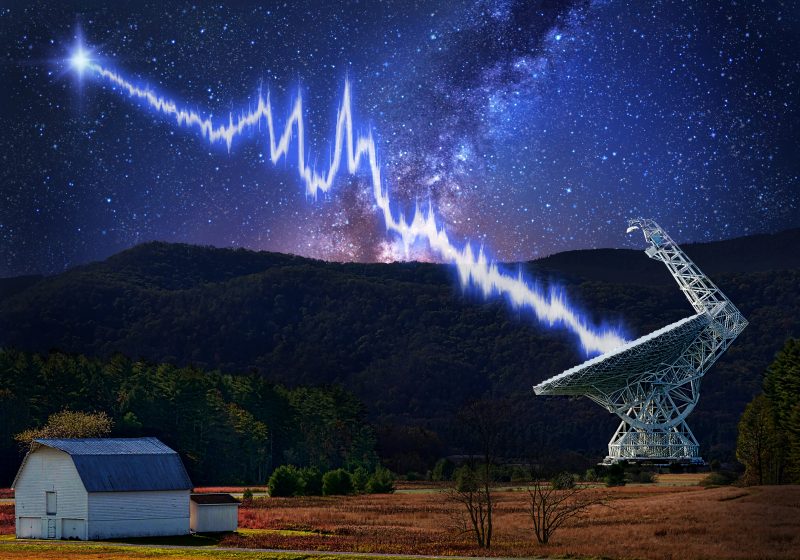
Astronomers reported today (January 10, 2018) at the winter meeting of the American Astronomical Society (AAS) in Washington, D.C. on their recent studies of a mysterious source of fast radio bursts – three billion light-years away – known as FRB 121102. They said the source of the bursts must be:
… in an astonishingly extreme and unusual environment. This discovery suggests that the strange source is in the close vicinity of a massive black hole, or within a nebula of unprecedented power.
Their study is featured on the cover of the January 11, 2018 edition of the peer-reviewed journal Nature.

FRB 121102 emits unpredictable bright pulses of radio emission, of extremely short duration (on the order of milliseconds). About 30 other sources of fast radio bursts, in other parts of the sky, are also known. But FRB 121102 is the only one known so far to repeat. That’s why – a year ago, at last winter’s AAS meeting – astronomers excitedly reported results of a breakthrough study, which had pinpointed FRB 121102’s location in the sky. Identifying its home galaxy, they said, would improve their chances of understanding the cause of the bursts.
Now, indeed, they do appear closer to that undertanding.

In 2017, an international team of astronomers used two of the world’s largest radio telescopes – at the Arecibo Observatory in Puerto Rico, and the Green Bank Observatory in West Virginia – to show that the radio bursts from the source FRB 121102 have a property known as polarization. One statement explained:
The behavior of this polarized light allows them to probe the source’s environment in a new way and to `peer into the lair’ of the mysterious burster.
Polarized light is likely familiar to anyone who has used polarized sunglasses to cut down on the glare of sunlight reflected off water. If polarized radio waves travel through a region with a magnetic field, the polarization gets ‘twisted’ by an effect known as Faraday rotation: the stronger the magnetic field, the greater the twisting.
The amount of twisting observed in FRB 121102’s radio bursts is among the largest ever measured in a radio source, and the researchers conclude that the bursts are passing through an exceptionally strong magnetic field in a dense plasma (a hot, ionized gas).

Astronomer Daniele Michilli, who participated in the study, said:
The only known sources in the Milky Way that are twisted as much as FRB 121102 are in the galactic center, which is a dynamic region near a massive black hole. Maybe FRB 121102 is in a similar environment in its host galaxy.
However, the twisting of the radio bursts could also be explained if the source is located in a powerful nebula or supernova remnant.
With a number of wide-field radio telescopes now coming online, more such sources are expected to be discovered in the coming year, these astronomers said. They’re excited! And they’re poised to answer more fundamental questions about fast radio bursts.
National Radio Astronomy Observatory VLA fast radio burst animation from NRAO Outreach on Vimeo.
Bottom line: Astronomers reported on January 10, 2018 on their recent studies of the mysterious source of fast radio bursts – three billion light-years away – known as FRB 121102. They now think the bursts were twisted by the extreme environment around a supernova or supermassive black hole.
Source: An extreme magneto-ionic environment associated with the fast radio burst source FRB 121102











